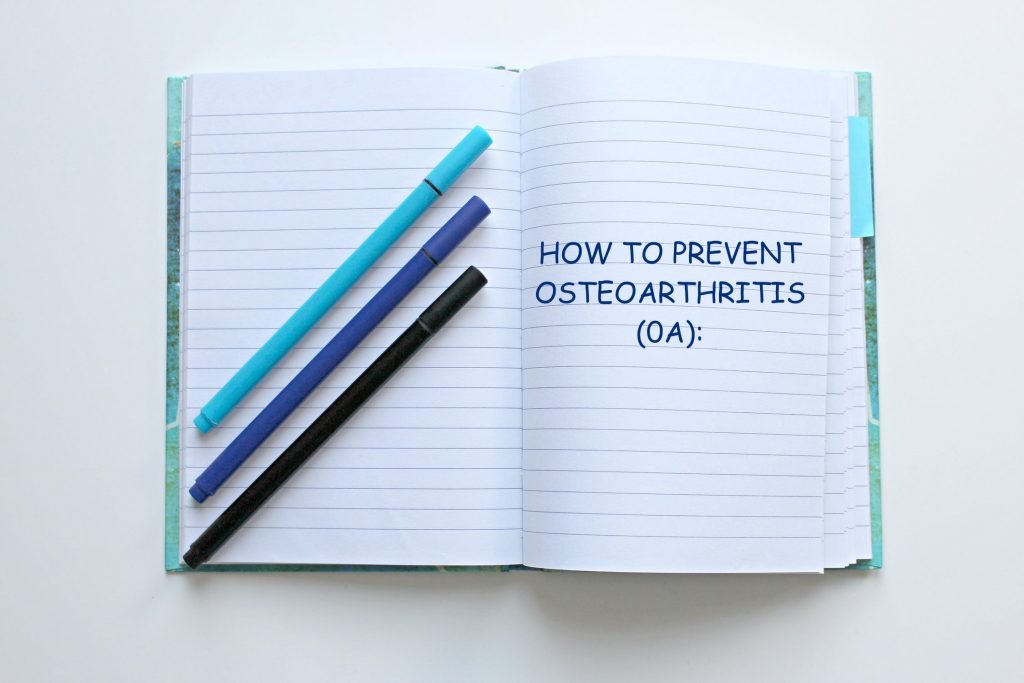Osteoarthritis (OA) is the most common type of arthritis and one of the fastest growing chronic conditions worldwide. A recent study found that by 2031, OA will cost the Canadian economy an estimated 17.5 billion annually in lost productivity as the disease limits people’s ability to work.

However, there are evidence-based strategies to reduce the risk of osteoarthritis through injury prevention programs and weight management strategies. The Osteoarthritis Action Alliance (OAAA or OA Action Alliance) covers such information under the Prevention module of their Osteoarthritis Prevention & Management in Primary Care Toolkit. Below, we highlight information from this Toolkit, as well as other resources related to OA prevention for both clinicians and patients.
Weight Management
The Osteoarthritis Action Alliance emphasizes the importance of a healthy body weight in preventing OA. The reason being that “excess weight increases the biomechanical load on weight-bearing joints, which can disrupt joint integrity and lead to pain”. This is supported by findings from Arthritis Research Canada’s senior scientist Dr. Jolanda Cibere. In her study, participants who were considered obese had a three times greater risk of knee swelling over 3 years, compared to participants who were not obese.
Engaging in the following behaviours when possible* may help maintain a healthy body weight:
- Reducing sugary drink consumption and replacing these drinks with water
- Decreasing sedentary time and increasing physical activity
- Choosing food options that are low in added sugars, calories and solid fats. See Canada’s Food Guide for more information and resources on healthy eating.

The OA Action Alliance also encourages physicians to sensitively discuss weight loss with patients who are overweight. This is important because, “A 10-pound weight loss in someone who is overweight can reduce the risk of knee OA by 50%”. The following infographic can help to guide clinicians through discussing weight loss with patients:

* Structural barriers such as income, disability and geographical location can limit a person’s ability to engage in certain health behaviours. It’s important for clinicians to be mindful of these cases and focus on lifestyle changes that are accessible for the patient. Clinicians should provide the patient with information on local food security programs when applicable.
Joint Injury Prevention and Care
Joint injuries, particularly fractures, can lead to development of OA, specifically a form known as post-traumatic osteoarthritis. As highlighted by the OAAA, “post-traumatic OA makes up approximately 12% of all OA cases and can result from injuries sustained in automobile or military accidents, falls, or sports”. Additional risk is associated with anterior cruciate ligament (ACL) injury: regardless of initial treatment strategy, an estimated 1 in 3 patients have radiographic OA (joint damage visible on an X-ray) within a decade of experiencing ACL injury. This makes injury prevention particularly important. To prevent injury, stretching and strengthening exercises should be practiced in all levels of sport, from youth to professional adults and if an injury has been sustained, protective gear should be worn to prevent re-injury.
A separate ABN posts also covers the topic of youth sport injury and OA, featuring research by Dr. Jackie Whittaker. Youth sport injuries, if not treated properly, can not only lead to post traumatic OA within 15 years, but can also lead to obesity later in life. This means that youth with one major risk factor for OA (joint injury) are in danger of acquiring a second risk factor for the disease (obesity). As coaches and parents, we can promote proper warm-up activities to prevent injury, ensure injuries are treated in a timely manner and encourage youth to be fully healed from injuries before returning to play:
1. Warm up prior to practices and games: FIFA 11+ is a warm-up program developed by FIFA’s Medical Assessment and Research Centre. Research shows that FIFA11+ can reduce injuries by 40%. The program is about 20 minutes long and includes running, active stretching, strength, balance, plyometric exercises and an emphasis on technique, alignment, agility and landings. Plyometrics, also known as jump training or plyos, are exercises in which muscles exert maximum force in short intervals of time, with the goal of increasing power, speed and strength. Movement Preparation is the Canadian physical literacy program that uses similar exercises as FIFA 11+ but is geared towards younger soccer players, aged 7-13 years
2. Following an injury, it is important to get the proper medical care and assessment. Self-care methods include icing, compression, elevation and using protective gears (such as ankle braces). It is important to rule out serious injury (e.g. broken bone). Your physician may recommend you visit a physiotherapist for continued care.
3. Allow injuries to fully heal before returning to play. These are the signs that it is safe for youth to return to a sport after injury:
- No pain
- No swelling
- Location of injury feels strong
- Able to sprint, run and jump
- Confident and no fear of re-injury